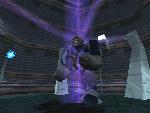Redwood's Half-Life Preview Page 2
Graphics/EngineHalf-Life uses portions of the Quake/Quake II engine. Jay Stelly, senior software engineer at Valve, is one of the key people that has helped extend the engine extensively to give players a much richer experience, and to make it easy for other developers to do the same. One major difference between Half-Life's engine and Quake's engine is the move from an 8-bit to a 16-bit palette for the textures with which the environment is filled. Other graphic luxuries include volumetric lighting, which gives you that feeling of being "in" the light. Waves in the water are a nice effect done in hardware, while water droplets with ripples are in the software version. The waves can be adjusted to different levels too. Another particularly impressive feature is the "beam" effects. Beam effects include such things as electricity moving around objects and the most realistic 3D lightning ever seen. Yes, that includes Unreal's lightning, which is quite nice by itself. Jay also says smoke will be in the game, but I did not see this feature.One really nice improvement that I have not seen done this well in other games is the addition of so called "decals." The decal system is a way of dynamically layering textures in the game so the environment can be changed in a more realistic manner. This means you can do things like leave bullet marks on anything you shoot at or scorch marks from grenades. These looked so real that I often shot things up just to see the decals. Scorch marks overlay each other realistically, getting darker the more that the spot gets touched. What is actually happening is the textures are being laid on top of each other. Wire glass gets spidery cracks in it around the bullet holes before eventually shattering. The best part is that you can use these in deathmatch so you can mark your kills, taunt your foes, and give the place a war-torn look. To everybody's liking, blood splatters at the right spot on the wall when you shoot or kill somebody. You will be able to spray paint spots to mark where you are in the level or how to get out. You may have also heard that Blue's famed blue smiley face is also a decal in the game. While I was there, the guys quickly whipped up a rocket decal from my logo that can be placed on any surface in the game. Half-Life also has a very nice looking chrome effect. For instance, when the female ninja enemy looks at you, you can see her goggles glisten. Metal parts on alien armor also have a nice chrome look to them, as does the 44 magnum weapon. Another lighting effect is call the lenticular halo, a sort of glare around lights that changes depending on your location relative to the light. Non-graphic engine improvements include objects that bob/float/sink in water depending on the mass assigned. For instance, if you push a wood box into the water, it won't automatically sink or automatically float. Instead, it will go down well into the water then rise up, then down, until it finally settles into a slow bobbing. Push a stack of bricks into the water and it will sink to the bottom, as you would expect in real life. That real life feeling is what Valve is going for in this game, but not to the point where it is not fun. They want you to believe you are actually there and know that little details add up. These features are not just little tricks to show off to your friends, effects that are part of the gameplay experience-you'll need to understand how they work in order to get through the game at some point. You can even shoot floating wood boxes to pieces when your deathmatch buddies may be walking on them, dropping them into the water for an easy kill. Water can also be electrified at the flick of a switch as well. Another tweak that Jay Stelly has put in is the quick loading of levels. These level changes take place in the middle of hallways and happen in a matter of 1 to 2 seconds. You can see and shoot through the level transition as well, which makes the world very seamless. Jay showed me a spot with a transition up some stairs. He shot a grenade through the transition, went through the transition, then saw the grenade hit and explode inside the other level. I wish everybody put in a feature like this. As far as expandability is concerned, Jay told me that the engine uses DLLs, like Quake 2 does, except in a different way. He says they hope to have mods able to work with each other. That would be a great feature if they can work out the details.
|
 Jolted Alient Grunt |